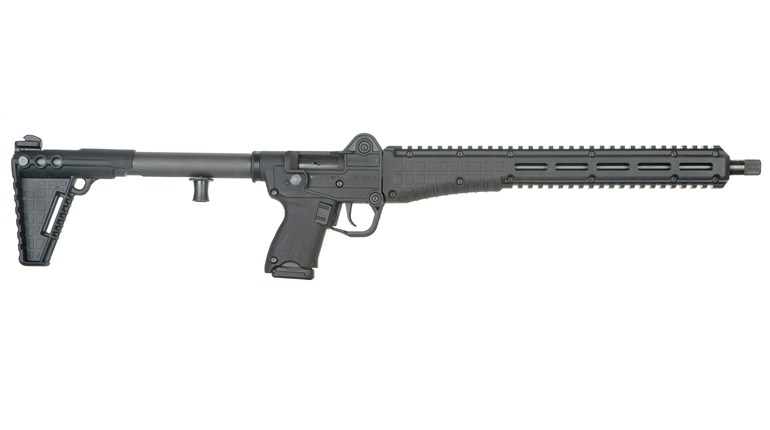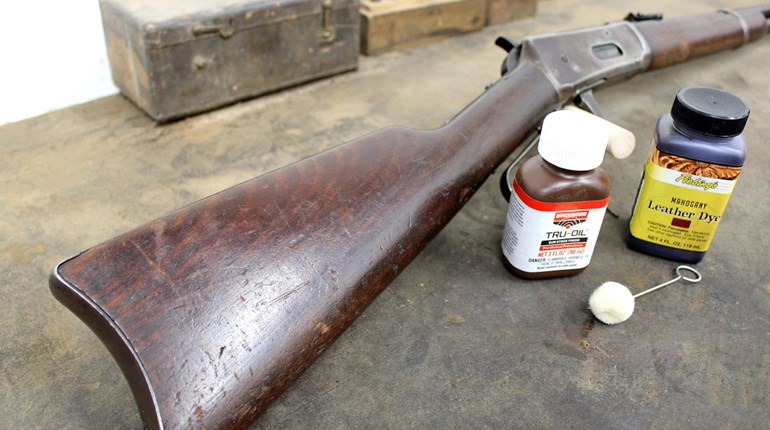
The days of blue steel and walnut as the defining style of firearms are long behind us. One company leading that charge was Kel-Tec. Its embrace of polymer and black-oxidized steel with almost industrial looks is the new baseline for firearms. And, the latest in its line of “why didn’t I think of that” firearms is the P50.
To start, the P50 is chambered in 5.7x28 mm. The 5.7 is not new. It has now been around for 30 years, and was just formally adopted by NATO. What made it not commonly seen on ranges was the dearth of options to use it. For most of its existence, only two firearms—both pretty pricey—were chambered for the round. With recent introductions from Ruger, CMMG, Diamondback and now Kel-Tec, however, there’s a lot of new life for this little speed demon. Not only is the P50 priced noticeably less than the original FN options, it also makes use of the most generous-capacity magazines to be had for the 5.7x28 mm.
The P50 is a semi-automatic, delayed-blowback pistol that uses the 50-round magazines of the FN PS90 carbine. The P50 appears bulky, but the size is belied by its relatively light weight of 51 ounces empty. I have used heavier pistols in competitions, and none of them had a 50-round magazine.

On top, the P50 has a full-length Picatinny rail with plenty of room to mount whatever optic you choose. Matching it on the bottom of the receiver is a shorter rail for a light or laser. The groove down the center of the top rail is also where the iron sights are mounted, which is useful, but I imagine most users will quickly mount the most compact red-dot sight they can find to make the P50 even more handy.
With a nearly 10-inch barrel, the P50 offers a significant boost in velocity over the much shorter barrel of other 5.7x28 mm pistols. The muzzle is threaded for a suppressor, and comes with a thread protector installed.
Behind that lower rail, Kel-Tec has placed a curved hand-grip for your off hand, directly below the center of balance. The trigger guard and the pistol grip are just behind that hump. The Kel-Tec idea of a pistol grip in proportion and shape is exactly to my taste. It is relatively slim, with definite flat sides, so it indexes well. It is covered with large, rectangular, non-slip gripping blocks and the surface has a fine-grain texture to add to the secure grip.
Kel-Tec has positioned all the controls you need above and behind the pistol grip. Directly above the pistol grip is the safety, which is ambidextrous. With the lever pointing back, the P50 is on “safe,” with it pivoted to point down, it is on “fire.” Just above where you grip, Kel-Tec has located the receiver latch. Press this latch down, and the P50 unlocks with a click. To load, unload or reload, you push the selector to safe, then press the latch down. Hinge the upper-receiver assembly (the pivot point is below the muzzle) and you can access the magazine. Above that, Kel-Tec has provided a QD sling socket, which offers interesting possibilities for shooting. The charging handle is above the QD socket, and it, too, is ambidextrous, with two tabs you can grasp. While not an AR-15-compatible part, it functions in much the same way in terms of user interface.

Loading is simple. Put the P50 on safe, unlock the receiver assembly and hinge the upper receiver up. Hold the upper with your off hand and grab your magazine with your firing hand. Place the front end of the magazine in the gap in the upper created by a pair of sheet-metal fingers and hinge the magazine up toward the upper receiver. Press the magazine (with the cartridge ready to feed up, toward the upper) into the upper receiver until it clicks into place. Now reach down, grab the lower and hinge it up to the upper. The first few times you do this, it will seem counterintuitive. Every shooter I’ve handed the P50 to without telling them how to load tries to put the magazine in the lower and then close the upper down onto it. When you do this, the magazine will invariably shift, and the receivers won’t close. Once they are closed, you grasp the charging handle, pull back, let go and you are ready—just like on an AR, which this is decidedly not. To shoot, aim, press the selector to fire, then press the trigger.
The ejection port on the P50 is on the top of the upper receiver and empties are ejected up and somewhat to the right. Keep the ejection port location in mind when you are mounting optics, as you do not want to block the path of the empty brass.
The QD sling socket is both a way to carry the P50 and a useful support for aiming. If you use a bungee-type sling locked into the socket and adjust the sling so it tensions when you press your hands forward while holding the P50, the sling provides some added stability. Yes, this is the technique the Special Air Service (SAS) developed for use with the H&K MP5, half a century ago.
I did not perform accuracy testing this way, but rather tested the P50 while sitting at a shooting bench and resting it on sandbags. For that, I mounted an Aimpoint Micro T1, which, while not the most compact red-dot optic to be found (although it’s close to it for a non-slide-mounted sight) it was handy, worked like a charm and it allowed me to wring out more accuracy from the P50.

The P50 came with two 50-round magazines, and loading them is another learning experience. The magazine holds the rounds horizontally, and at a right angle to the axis of the bore. The feed ramp built into the magazine (in the circular boss on one end) spirals each cartridge up and into line with the chamber. To load, the first round is done normally: press it down into the feed lips and push it back until it stops. Just remember the correct orientation: bullet tip pointed down the length of the magazine. The second round won’t be as easy, and the third will seem impossible—if you follow the same pattern. Instead, take every round after the first one and press the base of that cartridge straight down onto the cartridge in the feed lips, on the neck. When you press, you’ll see the already-loaded round snap over to half the rotation point. You can now, while maintaining pressure, tilt the round you are loading down into line with the feed lips and press it back. Repeat until the magazine is full. The normal method of loading a pistol magazine does not offer the leverage the P50 magazine requires to press rounds down the spiral ramp inside the magazine, so you have to learn new skills.
On top, the P50 has a full-length Picatinny rail with plenty of room to mount whatever optic you choose. Matching it on the bottom of the receiver is a shorter rail for a light or laser.
With a nearly 10-inch barrel, the P50 offers a significant boost in velocity over the much shorter barrel of other 5.7x28 mm pistols. The muzzle is threaded for a suppressor, and comes with a thread protector installed. As the 5.7 round depends on velocity for its effectiveness, this is a good thing. With a boost of some 250 to 325 fps, depending on the ammunition used, the P50 delivers more energy than smaller pistols.
And there’s the crux of the P50: size. Yes, it is not overly heavy for its size, but it is rather bulky for a handgun. However, that bulk gains you two advantages: added velocity and extra capacity. Besides being grand fun on the range (and a magnet to other shooters on the line) what is the P50 for? I can see it as a cracking-good home-defense tool. With the bungee sling and a light/laser combo mounted on the lower rail, it offers a light, relatively compact (much more so than a rifle or shotgun) defensive firearm, with plenty of capacity and light recoil. Even with a 40-grain bullet exiting the muzzle at speeds in excess of 2,000 fps, recoil is no big deal.

At $200 or $800 less than either of the original FN 5.7s, and not quite $200 more than the Ruger-57 (which offers a “mere” 20-round magazine), the Kel-Tec P50 is perfectly positioned to be a serious competitor to both lines. Once ammunition is actually available again, we can all get back to practice. And with the P50, practice will be fun.








































